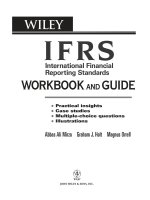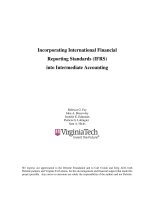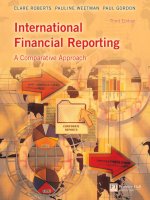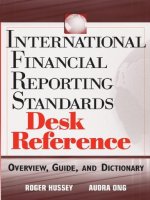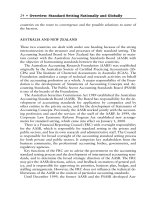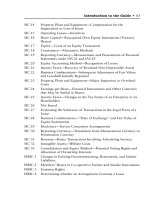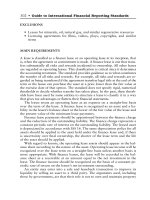International financial reporting standards 5e by hennie van greuning
Bạn đang xem bản rút gọn của tài liệu. Xem và tải ngay bản đầy đủ của tài liệu tại đây (2.77 MB, 348 trang )
Public Disclosure Authorized
Public Disclosure Authorized
Public Disclosure Authorized
Public Disclosure Authorized
48334
HENNIE VAN GREUNING
INTERNATIONAL
FINANCIAL
REPORTING STANDARDS
A PRACTICAL GUIDE
FIFTH EDITION
International Financial
Reporting Standards
A Practical Guide
Fifth Edition
Hennie van Greuning
Washington, D.C.
© 2009 International Bank for Reconstruction and Development and the World Bank
1818 H Street, NW Washington, DC 20433
Telephone: 202-473-1000
Internet: www.worldbank.org
E-mail:
All rights reserved.
1 2 3 4 5 13 12 11 10 09
The findings, interpretations, and conclusions expressed herein are those of the author(s) and do not
necessarily reflect the views of the Board of Executive Directors of the World Bank or the governments
they represent.
The World Bank does not guarantee the accuracy of the data included in this work. The boundaries,
colors, denominations, and other information shown on any map in this work do not imply any judgment on the part of the World Bank concerning the legal status of any territory or the endorsement or
acceptance of such boundaries.
Rights and Permissions
The material in this work is copyrighted. Copying and/or transmitting portions or all of this work without permission may be a violation of applicable law. The World Bank encourages dissemination of its
work and will normally grant permission promptly.
For permission to photocopy or reprint any part of this work, please send a request with complete information to the Copyright Clearance Center, Inc., 222 Rosewood Drive, Danvers, MA 01923, USA,
telephone 978-750-8400, fax 978-750-4470, www.copyright.com.
All other queries on rights and licenses, including subsidiary rights, should be addressed to the Office of
the Publisher, World Bank, 1818 H Street NW, Washington, DC 20433, USA, fax 202-522-2422, e-mail
ISBN: 978-0-8213-7727-7
eISBN: 978-0-8213-7899-1
DOI: 10.1596/978-0-8213-7727-7
Library of Congress Cataloging-in-Publication Data has been requested.
Contents
PART &
CHAPTER
STANDARD
NUMBER
TITLE
PAGE
Foreword
v
Acknowledgments
vi
Introduction
vii
About the Author
ix
PART I
FINANCIAL STATEMENT PRESENTATION
1
Framework
Framework for the Preparation and Presentation of Financial Statements
2
IFRS 1
First-Time Adoption of IFRS
12
3
IAS 1
Presentation of Financial Statements
16
4
IAS 7
Cash Flow Statements
34
5
IAS 8
Accounting Policies, Changes in Accounting Estimates, and Errors
46
PART II
2
GROUP STATEMENTS
6
IFRS 3
Business Combinations
56
7
IAS 27
Consolidated and Separate Financial Statements
68
8
IAS 28
Investments in Associates
76
9
IAS 31
Interests in Joint Ventures
82
PART III
STATEMENT OF FINANCIAL POSITION / BALANCE SHEET
10
IAS 16
Property, Plant, and Equipment
11
IAS 40
Investment Property
106
12
IAS 41
Agriculture
112
13
IAS 38
Intangible Assets
120
14
IAS 17
Leases
126
15
IAS 12
Income Taxes
140
16
IAS 2
Inventories
150
17
IAS 39
Financial Instruments: Recognition and Measurement
160
18
IFRS 5
Noncurrent Assets Held for Sale and Discontinued Operations
176
19
IFRS 6
Exploration for and Evaluation of Mineral Resources
182
20
IAS 37
Provisions, Contingent Liabilities, and Contingent Assets
188
21
IAS 21
The Effects of Changes in Foreign Exchange Rates
194
PART IV
92
STATEMENT OF COMPREHENSIVE INCOME / INCOME STATEMENT
22
IAS 18
Revenue
204
23
IAS 11
Construction Contracts
212
24
IAS 19
Employee Benefits
222
25
IAS 36
Impairment of Assets
232
26
IAS 23
Borrowing Costs
240
27
IAS 20
Accounting for Government Grants and Disclosure of Government Assistance
248
28
IFRS 2
Share-Based Payment
254
29
IAS 10
Events After the Balance Sheet Date
264
A Practical Guide ■ Contents
iii
PART &
CHAPTER
STANDARD
NUMBER
TITLE
PART V
iv
PAGE
DISCLOSURE
30
IAS 24
Related-Party Disclosures
270
31
IAS 33
Earnings per Share
276
32
IAS 32
Financial Instruments: Presentation
284
33
IFRS 7
Financial Instruments: Disclosures
288
34
IFRS 8
Operating Segments
306
35
IAS 34
Interim Financial Reporting
312
36
IAS 26
Accounting and Reporting by Retirement Benefit Plans
318
37
IFRS 4
Insurance Contracts
324
38
IAS 29
Financial Reporting in Hyperinflationary Economies
330
International Financial Reporting Standards ■ Contents
Foreword
The publication of this fifth edition coincides with the convergence in accounting standards
that has been a feature of the international landscape since the global financial crisis of 1998.
The events of that year prompted several international organizations, including the World Bank
and the International Monetary Fund, to launch a cooperative initiative to strengthen the global
financial architecture and to seek a longer-term solution to the lack of transparency in financial
information. International convergence in accounting standards under the leadership of the International Accounting Standards Board (IASB) and the Financial Accounting Standards Board
(FASB) in the United States has now progressed to the point where more than 100 countries
currently subscribe to the International Financial Reporting Standards (IFRS).
In the U.S., the August 2008 announcement that the SEC proposes that IFRS reporting begin with 2014 filings, subject to certain interim milestones being met, will no doubt accelerate
convergence. The AICPA response was positive in stating that one set of master standards will
ultimately lead to investment comparisons on a worldwide basis as well as enable cross border
transactions to be more transparent and reliable. From December 2009 onwards one can therefore expect limited early use by entities in the U.S. By 2011 the SEC will determine whether to
require mandatory adoption of IFRS for all U.S. issuers by 2014.
The rush toward convergence continues to produce a steady stream of revisions to accounting
standards by both the IASB and FASB. For accountants, financial analysts, and other specialists, there is already a burgeoning technical literature explaining in detail the background and
intended application of these revisions. This book provides a non-technical, yet comprehensive,
managerial overview of the underlying materials.
The appearance of the fifth edition of this book—already translated into 15 languages in its earlier editions—is therefore timely.
Each chapter briefly summarizes and explains a new or revised IFRS, the issue or issues the
standard addresses, the key underlying concepts, the appropriate accounting treatment, and the
associated requirements for presentation and disclosure. The text also covers financial analysis
and interpretation issues to better demonstrate the potential effect of the accounting standards
on business decisions. Simple examples in most chapters help further clarify the material. It is
our hope that this approach, in addition to providing a handy reference for practitioners, will
help relieve some of the tension experienced by nonspecialists when faced with business decisions influenced by the new rules. The book should also assist national regulators in comparing
IFRS to country-specific practices, thereby encouraging even wider local adoption of these already broadly accepted international standards. It also forms the basis of a securities accounting
workshop offered several times each year to World Bank Treasury clients in central banks and
other public sector funds.
Kenneth G. Lay, CFA
Treasurer
The World Bank
Washington, D.C.
January 2009
A Practical Guide ■ Foreword
v
Acknowledgments
The author is grateful to Ken Lay, vice president and treasurer of the World Bank, who has supported this fifth edition as a means to assist our client countries with a publication to facilitate
understanding the International Financial Reporting Standards (IFRS) and emphasize the importance of financial analysis and interpretation of the information produced through application of these standards.
Charles Hattingh of PC Finance Research (South Africa) has provided invaluable insights into
the complexities and implementation problems of IFRS.
The Stalla Review for the CFA® exam made a significant contribution to a previous edition by
providing copyright permission to adapt material and practice problems from its textbooks and
questions database.
I am grateful to the International Accounting Standards Committee Foundation for the use of
its examples in chapter 12 (IAS 41–Agriculture). In essence, this entire publication is a tribute
to the output of the International Accounting Standards Board. Deloitte Touche Tohmatsu also
allowed the use of two examples from its publications.
Colleagues in the World Bank Treasury shared their insights into the complexities of applying
certain standards to the treasury environment. I benefited greatly from hours of conversation
with many colleagues, including Hamish Flett and Richard Williams.
Despite the extent and quality of the inputs that I have received, I am solely responsible for the
contents of this publication.
Hennie van Greuning
January 2009
THE WORLD BANK TREASURY
Washington, D.C.
vi
International Financial Reporting Standards ■ Acknowledgments
Introduction
This text, based on four earlier editions that have already been translated into 15 languages, is an
important contribution to expanding awareness and understanding of International Financial
Reporting Standards (IFRS) around the world, with easy-to-read summaries of each standard
and examples that illustrate accounting treatments and disclosure requirements.
TARGET AUDIENCE
A conscious decision has been made to focus on the needs of executives and financial analysts
in the private and public sectors who might not have a strong accounting background. This publication summarizes each standard (whether it is an IFRS or an International Accounting Standard) so managers and analysts can quickly obtain a broad overview of the key issues. Detailed
discussion of certain topics has been excluded to maintain the overall objective of providing a
useful tool to managers and financial analysts.
In addition to the short summaries, most chapters contain basic examples that emphasize the
practical application of some key concepts in a particular standard. This text provides the tools to
enable an executive without a technical accounting background to (1) participate in an informed
manner in discussions relating to the appropriateness or application of a particular standard in a
given situation, and (2) evaluate the effect that the application of the principles of a given standard will have on the financial results and position of a division or of an entire enterprise.
STRUCTURE OF THIS PUBLICATION
Each chapter follows a common outline to facilitate discussion of each standard:
1. Objective of Standard identifies the main objectives and the key issues of the standard.
2. Scope of the Standard identifies the specific transactions and events covered by a standard.
In certain instances, compliance with a standard is limited to a specified range of enterprises.
3. Key Concepts explains the usage and implications of key concepts and definitions.
4. Accounting Treatment lists the specific accounting principles, bases, conventions, rules,
and practices that should be adopted by an enterprise for compliance with a particular standard. Recognition (initial recording) and measurement (subsequent valuation) are specifically dealt with, where appropriate.
5. Presentation and Disclosure describes the manner in which the financial and nonfinancial items should be presented in the financial statements, as well as aspects that should be
disclosed in these financial statements—keeping in mind the needs of various users. Users
of financial statements include investors, employees, lenders, suppliers or trade creditors,
governments, tax and regulatory authorities, and the public.
A Practical Guide ■ Introduction
vii
6. Financial Analysis and Interpretation discusses items of interest to the financial analyst in chapters where such a discussion is deemed appropriate. None of the discussion in
these sections should be interpreted as a criticism of IFRS. Where analytical preferences
and practices are highlighted, it is to alert the reader to the challenges still remaining along
the road to convergence of international accounting practices and unequivocal adoption of
IFRS.
7. Examples are included at the end of most chapters. These examples are intended as further
illustration of the concepts contained in the IFRS.
The author hopes that managers in the client private sector will find this format useful in establishing accounting terminology, especially where certain terms are still in the exploratory stage
in some countries.
CONTENT INCLUDED
All of the accounting standards issued by the International Accounting Standards Board (IASB)
through December 31, 2008, are included in this publication. The IASB texts are the ultimate
authority—this publication merely constitutes a summary.
viii
International Financial Reporting Standards ■ Introduction
About the Author
Hennie van Greuning is a senior adviser in the World Bank’s Treasury and has previously worked
as a sector manager for financial sector operations in the Bank. He has been a partner in a major
international accounting firm and a controller in a central bank, in addition to heading bank
supervision in his home country. He is a CFA Charterholder and qualified as a Chartered Accountant. He holds doctoral degrees in both accounting and economics. He is the coauthor of
Analyzing and Managing Banking Risk, Risk Analysis for Islamic Banks, and International Financial
Statement Analysis.
A Practical Guide ■ About the Author
ix
Part I
Financial
Statement
Presentation
Chapter One
Framework for the Preparation and
Presentation of Financial Statements
1.1
OBJECTIVE
An acceptable coherent framework of fundamental accounting principles is essential for preparing financial statements. The major reasons for providing the framework are to
■
■
■
■
identify the essential concepts underlying the preparation and presentation of financial statements;
guide standard setters in developing accounting standards;
assist preparers, auditors, and users to interpret the International Financial Reporting Standards (IFRS); and
provide principles, as not all issues are covered by the IFRS.
The framework sets guidelines and should not be seen as a constitution, as there are certain instances
where individual standards vary from the principles established in this chapter.
1.2
SCOPE OF THE FRAMEWORK
The existing framework deals with the
■
■
■
■
■
■
objectives of financial statements,
qualitative characteristics of financial statements,
elements of financial statements,
recognition of the elements of financial statements,
measurement of the elements of financial statements, and
concepts of capital and capital maintenance.
The framework is not a standard, but it is used extensively by the International Accounting Standards
Board (IASB) and by its International Financial Reporting Interpretations Committee (IFRIC).
1.3
KEY CONCEPTS
Objective of Financial Statements
1.3.1
2
The objective of financial statements is to provide information about the financial position
(balance sheet), performance (income statement), and changes in financial position (cash
Chapter One ■ Framework for the Preparation and Presentation of Financial Statements
flow statement) of an entity. This information should be useful for making economic decisions
by the users of the financial statements, who cannot dictate the information they should be getting.
1.3.2
Financial statements also show the results of management’s stewardship of the resources entrusted to it. This information, along with other information in the notes to the financial statements, assists users of financial statements in predicting the entity’s future cash flows and, in
particular, their timing and certainty. To meet this objective, financial statements provide information about an entity’s
■
assets;
■
liabilities;
equity;
income and expenses, including gains and losses;
contributions by and distributions to owners in their capacity as owners; and
cash flows.
■
■
■
■
1.3.3
Fair presentation is achieved through the provision of useful information (full disclosure) in the
financial statements, whereby transparency is secured. If one assumes that fair presentation is
equivalent to transparency, a secondary objective of financial statements is to secure transparency
through full disclosure and provide a fair presentation of useful information for decision-making
purposes.
Qualitative Characteristics
1.3.4
Qualitative characteristics are the attributes that make the information provided in financial statements useful to users:
■
■
■
■
1.3.5
Understandability. Information should be readily understandable by users who have a basic
knowledge of business, economic activities, and accounting, and who have a willingness to
study the information with reasonable diligence.
Relevance. Relevant information influences the economic decisions of users, helping them
to evaluate past, present, and future events or to confirm or correct their past evaluations. The
relevance of information is affected by its nature and materiality.
Reliability. Reliable information is free from material error and bias and can be depended
upon by users to represent faithfully that which it either purports to represent or could reasonably be expected to represent. The following factors contribute to reliability: faithful representation, substance over form, neutrality, prudence, and completeness.
Comparability. Information should be presented in a consistent manner over time and in a
consistent manner between entities to enable users to make significant comparisons.
The following are the underlying assumptions of financial statements (see figure 1.1 at the end of
the chapter):
■
Accrual basis. Effects of transactions and other events are recognized when they occur (not
when the cash flows). These effects are recorded and reported in the financial statements of
the periods to which they relate.
Chapter One ■ Framework for the Preparation and Presentation of Financial Statements
3
■
1.3.6
The following are constraints on providing relevant and reliable information:
■
■
1.4
Going concern. It is assumed that the entity will continue to operate for the foreseeable
future.
Timeliness. Undue delay in reporting could result in loss of relevance but improve reliability.
Benefit versus cost. Benefits derived from information should exceed the cost of providing
it.
1.3.7
Balancing qualitative characteristics. To meet the objectives of financial statements and make
them adequate for a particular environment, providers of information must balance the qualitative characteristics in such a way that best meets the objectives of financial statements.
1.3.8
The application of the principal qualitative characteristics and the appropriate accounting standards normally results in financial statements that provide fair presentation.
ACCOUNTING TREATMENT
Elements of Financial Statements
1.4.1
The following elements of financial statements are directly related to the measurement of the
financial position:
■
■
■
1.4.2
Assets. Resources controlled by the entity as a result of past events and from which future
economic benefits are expected to flow to the entity
Liabilities. Present obligations of an entity arising from past events, the settlement of which
is expected to result in an outflow from the entity of economic benefits
Equity. Assets less liabilities (commonly known as shareholders’ funds)
The following elements of financial statements are directly related to the measurement of performance:
■
■
Income. Increases in economic benefits in the form of inflows or enhancements of assets, or
decreases of liabilities that result in an increase in equity (other than increases resulting from
contributions by owners). Income embraces revenue and gains.
Expenses. Decreases in economic benefits in the form of outflows or depletion of assets, or
incurrences of liabilities that result in decreases in equity (other than decreases because of
distributions to owners).
Initial Recognition of Elements
1.4.3
A financial statement element (assets, liabilities, equity, income, and expenses) should be recognized in the financial statements if
■
■
4
it is probable that any future economic benefit associated with the item will flow to or from
the entity, and
the item has a cost or value that can be measured with reliability.
Chapter One ■ Framework for the Preparation and Presentation of Financial Statements
Subsequent Measurement of Elements
1.4.4
The following bases are used to different degrees and in varying combinations to measure elements of financial statements:
■
■
■
■
Historical cost
Current cost
Realizable (settlement) value
Present value (fair market value)
Fair value has to be used to measure financial instruments, but it is optional for valuing property, plant and
equipment, intangible assets, and agricultural products.
Capital Maintenance Concepts
1.4.5
Capital and capital maintenance include
■
■
1.5
Financial capital is synonymous with net assets or equity; it is defined in terms of nominal
monetary units. Profit represents the increase in nominal money capital over the period.
Physical capital is regarded as the operating capability; it is defined in terms of productive
capacity. Profit represents the increase in productive capacity over the period.
PRESENTATION AND DISCLOSURE: TRANSPARENCY AND DATA QUALITY
1.5.1
In forming a safe environment for stakeholders, corporate governance rules should focus on
creating a culture of transparency. Transparency refers to making information on existing conditions, decisions, and actions accessible, visible, and understandable to all market participants.
Disclosure refers more specifically to the process and methodology of providing the information
and of making policy decisions known through timely dissemination and openness. Accountability refers to the need for market participants, including the relevant authorities, to justify their
actions and policies and to accept responsibility for both decisions and results.
1.5.2
Transparency is a prerequisite for accountability, especially to borrowers and lenders, issuers
and investors, national authorities, and international financial institutions. In part, the case for
greater transparency and accountability rests on the need for private sector agents to understand
and accept policy decisions that affect their behavior. Greater transparency improves economic
decisions taken by other agents in the economy. Transparency also fosters accountability, internal discipline, and better governance, while both transparency and accountability improve the
quality of decision making in policy-oriented institutions. Such institutions—as well as other
institutions that rely on them to make decisions—should be required to maintain transparency.
If actions and decisions are visible and understandable, the costs of monitoring can be lowered.
In addition, the general public is better able to monitor public sector institutions, shareholders
and employees have a better view of corporate management, creditors monitor borrowers more
adequately, and depositors are able to keep an eye on banks. Poor decisions do not go unnoticed
or unquestioned.
Chapter One ■ Framework for the Preparation and Presentation of Financial Statements
5
6
1.5.3
Transparency and accountability are mutually reinforcing. Transparency enhances accountability
by facilitating monitoring, while accountability enhances transparency by providing an incentive
for agents to ensure that their actions are disseminated properly and understood. Greater transparency reduces the tendency of markets to place undue emphasis on positive or negative news
and thus reduces volatility in financial markets. Taken together, transparency and accountability
also impose discipline that improves the quality of decision making in the public sector. This can
result in more efficient policies by improving the private sector’s understanding of how policy
makers may react to events in the future. Transparency forces institutions to face up to the reality
of a situation and makes officials more responsible, especially if they know they will have to justify
their views, decisions, and actions. For these reasons, timely policy adjustment is encouraged.
1.5.4
The provision of transparent and useful information on market participants and their transactions
is an essential part of an orderly and efficient market; it also is a key prerequisite for imposing
market discipline. For a risk-based approach to bank management and supervision to be effective,
useful information must be provided to each key player: supervisors, current and prospective
shareholders and bondholders, depositors and other creditors, correspondent and other banks,
counterparties, and the general public. Left alone, markets may not generate sufficient levels of
disclosure. Although market forces normally balance the marginal benefits and costs of disclosing
additional information, the end result may not be what players really need.
1.5.5
The public disclosure of information is predicated on the existence of quality accounting standards and adequate disclosure methodology. The process normally involves publication of relevant qualitative and quantitative information in annual financial reports, which are often supplemented by biannual or quarterly financial statements and other important information. Because
the provision of information can be expensive, disclosure requirements should weigh the usefulness of information for the public against the costs of providing it.
1.5.6
It is also important to time the introduction of information well. Disclosure of negative information to a public that is not sufficiently sophisticated to interpret it could damage an entity
(especially if it is a financial institution). In situations where low-quality information is put forth
or users are not deemed capable of properly interpreting what is disclosed, public requirements
should be phased in carefully and tightened progressively. In the long run, a full-disclosure regime
is beneficial, even if some immediate problems are experienced, because the cost to the financial
system of not being transparent is ultimately higher than the cost of revealing information.
1.5.7
The financial and capital market liberalization of the past decades brought increasing volatility
to financial markets and, consequently, increased the information needed to ensure financial stability. With the advance of financial and capital market liberalization, pressure has increased to
improve the usefulness of available financial sector information through the formulation of minimum disclosure requirements. These requirements address the quality and quantity of information that must be provided to market participants and the general public.
1.5.8
Transparency and accountability are not ends in and of themselves; nor are they panaceas to
solve all problems. They are designed to improve economic performance and the working of international financial markets by enhancing the quality of decision making and risk management
among market participants. In particular, transparency does not change the nature of banking or
the risks inherent in financial systems. Although it cannot prevent financial crises, transparency
may moderate the responses of market participants to bad news by helping them to anticipate
and assess negative information. In this way, transparency helps to mitigate panic and contagion.
Chapter One ■ Framework for the Preparation and Presentation of Financial Statements
1.5.9
A dichotomy exists between transparency and confidentiality. The release of proprietary information may enable competitors to take advantage of a particular situation, a fact that often deters
market participants from full disclosure. Similarly, monitoring bodies frequently obtain confidential information from financial institutions, which can have significant market implications.
Under such circumstances, financial institutions may be reluctant to provide sensitive information without the guarantee of client confidentiality. However, both unilateral transparency and
full disclosure contribute to a regime of transparency. If such a regime were to become the norm,
it would ultimately benefit all market participants, even if in the short term it would create discomfort for individual entities.
1.5.10 In the context of public disclosure, financial statements should be easy to interpret. Widely available and affordable financial information supports official and private monitoring of a business’s
financial performance. It promotes transparency and supports market discipline, two important
ingredients of sound corporate governance. Besides being a goal in itself, in that it empowers
stakeholders, disclosure could be a means to achieve better governance. The adoption of internationally accepted financial reporting standards is a necessary measure to facilitate transparency
and contribute to proper interpretation of financial statements.
1.5.11 In the context of fair presentation, no disclosure is probably better than disclosure of misleading
information. Figure 1.1 shows how transparency is secured through the IFRS framework.
Chapter One ■ Framework for the Preparation and Presentation of Financial Statements
7
Figure 1.1 Transparency in Financial Statements Achieved through Compliance with
IASB Framework
OBJECTIVE OF FINANCIAL STATEMENTS
To provide a fair presentation of
■
■
Financial position
Financial performance
■
Cash flows
TRANSPARENCY AND FAIR PRESENTATION
■
Fair presentation is achieved through providing useful information (full disclosure), which secures transparency.
■
Fair presentation equates with transparency.
SECONDARY OBJECTIVE OF FINANCIAL STATEMENTS
To secure transparency through a fair presentation of useful information (full disclosure)
for decision-making purposes
ATTRIBUTES OF USEFUL INFORMATION
Existing Framework
■ Relevance
■ Reliability
■ Comparability
■ Understandability
Alternative Views
■ Relevance
■ Predictive value
■ Faithful representation
■ Free from bias
■ Verifiable
Constraints
■
■
■
Timeliness
Benefit vs. cost
Balancing the qualitative characteristics
UNDERLYING ASSUMPTIONS
Accrual basis
8
Going concern
Chapter One ■ Framework for the Preparation and Presentation of Financial Statements
EXAMPLE: FRAMEWORK FOR THE PREPARATION AND PRESENTATION OF
FINANCIAL STATEMENTS
EXAMPLE 1.1
Chemco Inc. produces chemical products and sells them locally. The corporation wishes to extend its
market and export some of its products. The financial director realizes that compliance with international environmental requirements is a significant precondition if the company wishes to sell products
overseas. Although Chemco already has established a series of environmental policies, common practice
expects an environmental audit to be done from time to time, which will cost approximately $120,000.
The audit would encompass the following:
■
■
■
Full review of all environmental policy directives
Detailed analysis of compliance with these directives
Report containing in-depth recommendations of those physical and policy changes that
would be necessary to meet international requirements
The financial director of Chemco has suggested that the $120,000 be capitalized as an asset and then
written off against the revenues generated from export activities so that the matching of income and
expenses will occur.
EXPLANATION
The costs associated with the environmental audit can be capitalized only if they meet the definition and
recognition criteria for an asset. The IASB’s framework does not allow the recognition of items in the
balance sheet that do not meet the definition or recognition criteria.
To recognize the costs of the audit as an asset, it should meet both the
■
■
definition of an asset, and
recognition criteria for an asset.
For the costs associated with the environmental audit to comply with the definition of an asset, the
following should be valid:
i) The costs must give rise to a resource controlled by Chemco.
ii) The asset must arise from a past transaction or event, namely the audit.
iii) The asset must be expected to give rise to a probable future economic benefit that will flow
to the corporation, namely the revenue from export sales.
The requirements of (i) and (iii) are not met. Therefore, Chemco cannot capitalize the costs of the audit
because of the absence of fixed orders and detailed analyses of expected economic benefits.
To recognize the costs as an asset in the balance sheet, they must comply with the recognition criteria
(see §1.4.3), namely
■
■
The asset should have a cost that can be measured reliably.
The expected inflow of future economic benefits must be probable.
Chapter One ■ Framework for the Preparation and Presentation of Financial Statements
9
To properly measure the carrying value of the asset, the corporation must be able to demonstrate that
further costs will be incurred that would give rise to future benefits. However, the second requirement
poses a problem because of insufficient evidence of the probable inflow of economic benefits and would
therefore again disqualify the costs for capitalizing as an asset.
10
Chapter One ■ Framework for the Preparation and Presentation of Financial Statements
Chapter Two
First-Time Adoption of IFRS (IFRS 1)
2.1
OBJECTIVE
Specific issues occur with the first-time adoption of IFRS. IFRS 1 aims to ensure that the entity’s first financial statements (including interim financial reports for that specific reporting period) under IFRS provide a
suitable starting point, are transparent to users, and are comparable over all periods presented.
2.2
SCOPE OF THE STANDARD
IFRS 1 applies when an entity adopts IFRS for the first time by an explicit and unreserved statement of
compliance with IFRS. The standard specifically covers
■
comparable (prior period) information that is to be provided,
■
identification of the basis of reporting,
retrospective application of IFRS information, and
formal identification of the reporting and the transition date.
■
■
IFRS requires an entity to comply with each individual standard effective at the reporting date for its first
IFRS-compliant financial statements. Subject to certain exceptions and exemptions, IFRS should be applied retrospectively. Therefore, the comparative amounts, including the opening Statement of Financial
Position for the comparative period, should be restated from national generally accepted accounting principles (GAAP) to IFRS.
2.3
2.4
KEY CONCEPTS
2.3.1
The reporting date is the Statement of Financial Position date of the first financial statements that
explicitly state that they comply with IFRS (for example, December 31, 2005).
2.3.2
The transition date is the date of the opening Statement of Financial Position for the prior year
comparative financial statements (for example, January 1, 2004, if the reporting date is December
31, 2005).
ACCOUNTING TREATMENT
Opening Statement of Financial Position (Balance Sheet)
12
2.4.1
The opening IFRS Statement of Financial Position as of the transition date should recognize all
assets and liabilities whose recognition is required by IFRS, but not recognize items as assets or
liabilities whose recognition is not permitted by IFRS.
2.4.2
With regard to event-driven fair values, if fair value had been used for some or all assets and
Chapter Two ■ First-Time Adoption of IFRS (IFRS 1)
liabilities under a previous GAAP, these fair values can be used as the IFRS “deemed costs” at date
of measurement.
2.4.3
When preparing the opening Statement of Financial Position,
■
■
■
■
2.4.4
Recognize all assets and liabilities whose recognition is required by IFRS. Examples of changes
from national GAAP are derivatives, leases, pension liabilities and assets, and deferred tax on
revalued assets. Adjustments required are debited or credited to equity.
Remove assets and liabilities whose recognition is not permitted by IFRS. Examples of
changes from national GAAP are deferred hedging gains and losses, other deferred costs,
some internally generated intangible assets, and provisions. Adjustments required are debited
or credited to equity.
Reclassify items that should be classified differently under IFRS. Examples of changes from
national GAAP are financial assets, financial liabilities, leasehold property, compound financial
instruments, and acquired intangible assets (reclassified to goodwill). Adjustments required
are reclassifications between Statement of Financial Position items.
Apply IFRS in measuring assets and liabilities by using estimates that are consistent with
national GAAP estimates and conditions at the transition date. Examples of changes from
national GAAP are deferred taxes, pensions, depreciation, or impairment of assets. Adjustments required are debited or credited to equity.
Derecognition criteria of financial assets and liabilities are applied prospectively from the transition date. Therefore, financial assets and financial liabilities that have been derecognized under
national GAAP are not reinstated. However,
■
■
All derivatives and other interests retained after derecognition and existing at the transition
date must be recognized.
All special purposed entities (SPEs) controlled as of the transition date must be consolidated.
Derecognition criteria can be applied retroactively provided that the information needed was
obtained when initially accounting for the transactions.
2.4.5
Cumulative foreign currency translation differences on translation of financial statements of a
foreign operation can be deemed to be zero at transition date. Any subsequent gain or loss on
disposal of operation excludes pretransition-date translation differences.
Recognition of Assets
2.4.6
With regard to property plant and equipment, the following amounts can be used as IFRS
deemed cost:
■
■
2.4.7
Fair value at transition date
Pretransition-date revaluations, if the revaluation was broadly comparable to either fair value,
or (depreciated) cost adjusted for a general or specific price index
With regard to investment property, the following amounts can be used as IFRS “deemed cost”
under the cost model:
■
■
Fair value at transition date
Pretransition-date revaluations, if the revaluation was broadly comparable to either fair value,
or (depreciated) cost adjusted for a general or specific price index
Chapter Two ■ First-Time Adoption of IFRS (IFRS 1)
13
